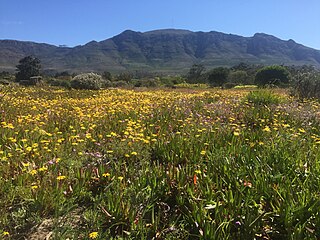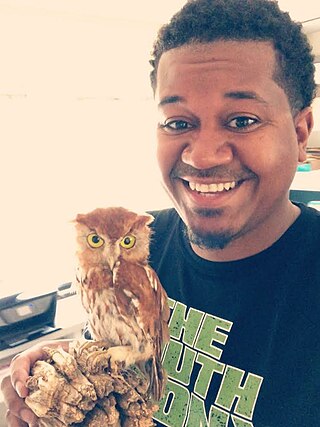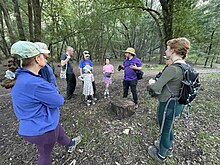
Edward Osborne Wilson was an American biologist, naturalist, ecologist, and entomologist known for developing the field of sociobiology.

Biodiversity is the variety and variability of life on Earth. It can be measured on various levels. There is for example genetic variability, species diversity, ecosystem diversity and phylogenetic diversity. Diversity is not distributed evenly on Earth. It is greater in the tropics as a result of the warm climate and high primary productivity in the region near the equator. Tropical forest ecosystems cover less than one-fifth of Earth's terrestrial area and contain about 50% of the world's species. There are latitudinal gradients in species diversity for both marine and terrestrial taxa.

Extinction is the termination of a taxon by the death of its last member. A taxon may become functionally extinct before the death of its last member if it loses the capacity to reproduce and recover. Because a species' potential range may be very large, determining this moment is difficult, and is usually done retrospectively. This difficulty leads to phenomena such as Lazarus taxa, where a species presumed extinct abruptly "reappears" after a period of apparent absence.

A BioBlitz, also written without capitals as bioblitz, is an intense period of biological surveying in an attempt to record all the living species within a designated area. Groups of scientists, naturalists, and volunteers conduct an intensive field study over a continuous time period. There is a public component to many BioBlitzes, with the goal of getting the public interested in biodiversity. To encourage more public participation, these BioBlitzes are often held in urban parks or nature reserves close to cities. Research into the best practices for a successful BioBlitz has found that collaboration with local natural history museums can improve public participation. As well, BioBlitzes have been shown to be a successful tool in teaching post-secondary students about biodiversity.

Citizen science is research conducted with participation from the general public, or amateur/nonprofessional researchers or participants for science, social science and many other disciplines. There are variations in the exact definition of citizen science, with different individuals and organizations having their own specific interpretations of what citizen science encompasses. Citizen science is used in a wide range of areas of study including ecology, biology and conservation, health and medical research, astronomy, media and communications and information science.

Lago Argentino is a lake in the Patagonian province of Santa Cruz, Argentina, at 50°2′S72°4′W. It is the largest freshwater lake in Argentina, with a surface area of 1,415 km2 (546 sq mi) and a maximum width of 20 mi (32 km). The lake's waters have an average depth of 155 m (509 ft), with a maximum depth of 500 m (1,640 ft).

The crested caracara, also known as the Mexican eagle, is a bird of prey in the falcon family, Falconidae. It is found from the southern and southeastern United States through Mexico and Central and South America, as well as some Caribbean islands. Documented rare sightings have occurred as far north as northern Minnesota and as far south as Tierra del Fuego.

The San Diego Natural History Museum is a museum located in Balboa Park in San Diego, California. It was founded in 1874 as the San Diego Society of Natural History. It is the second oldest scientific institution west of the Mississippi and the oldest in Southern California. The present location of the museum was dedicated on January 14, 1933. A major addition to the museum was dedicated in April 2001, doubling exhibit space.

eBird is an online database of bird observations providing scientists, researchers and amateur naturalists with real-time data about bird distribution and abundance. Originally restricted to sightings from the Western Hemisphere, the project expanded to include New Zealand in 2008, and again expanded to cover the whole world in June 2010. eBird has been described as an ambitious example of enlisting amateurs to gather data on biodiversity for use in science.

Earthwatch Institute is an international environmental charity. It was founded in 1971 as Educational Expeditions International by Bob Citron and Clarence Truesdale. Earthwatch Institute supports Ph.D. researchers internationally and conducts over 100,000 hours of research annually using the Citizen Science methodology. Earthwatch's mission statement states that the organization "connects people with scientists worldwide to conduct environmental research and empowers them with the knowledge they need to conserve the planet." As such, it is one of the global underwriters of scientific field research in climate change, archaeology, paleontology, marine life, biodiversity, ecosystems and wildlife. For over fifty years, Earthwatch has raised funds to recruit individuals, students, teachers, and corporate fellows to participate in field research to understand nature's response to accelerating global change.

Santa Clara County, officially the County of Santa Clara, is the sixth-most populous county in the U.S. state of California, with a population of 1,936,259 as of the 2020 census. Santa Clara County and neighboring San Benito County form the San Jose–Sunnyvale–Santa Clara metropolitan statistical area, which is part of the larger San Jose–San Francisco–Oakland combined statistical area. Santa Clara is the most populous county in the San Francisco Bay Area and in Northern California.

iNaturalist is an American 501(c)(3) nonprofit social network of naturalists, citizen scientists, and biologists built on the concept of mapping and sharing observations of biodiversity across the globe. iNaturalist may be accessed via its website or from its mobile applications. iNaturalist includes an automated species identification tool, and users further assist each other in identifying organisms from photographs. As of 24 February 2024, iNaturalist users had contributed approximately 172,751,520 observations of plants, animals, fungi, and other organisms worldwide, and around 350,000 users were active in the previous 30 days.
The Common Bird Monitoring Program is a citizen science bird monitoring program of India. It is a pioneer project that aims to engage general public in the collection of baseline data on 18 common bird species. Data collected will be used to map species abundance and distribution throughout the Indian subcontinent.

iSpot is a website developed and hosted by the Open University with funding from the Open Air Laboratories (OPAL) network with an online community intended to connect nature enthusiasts of all levels.

Tokai Park, previously known as "Tokai Forest", is a small wing, about 600 ha, of the greater Table Mountain National Park in Cape Town, South Africa. Tokai Park is made up of two sections: upper and lower Tokai Park. Lower Tokai Park is flat, and characterized by the threatened Cape Flats Sand Fynbos. Upper Tokai Park is on the slopes of Constantiaberg Mountain, and consists of conservation area as well as the Tokai Arboretum. Upper Tokai Park is characterized by Peninsula Granite Fynbos, Peninsula Sandstone Fynbos and Afromontane Forest and noted for its diversity.

Fungal Diversity Survey, or FunDiS, is a nonprofit citizen science organization formerly known as North American Mycoflora Project, Inc. FunDiS aims to document the diversity and distribution of fungi across North America “in order to increase awareness of their critical role in the health of ecosystems and allow us to better protect them in a world of rapid climate change and habitat loss.” The project encourages amateurs, working with professionals, to contribute observations to online databases vetted by experts, and to collect and document fungi for DNA barcoding. Fungal Diversity Survey, Inc. is a Charitable 501(c)(3) organization registered in Indiana, USA.

Insects are the most numerous and widespread class in the animal kingdom, accounting for up to 90% of all animal species. In the 2010s, reports emerged about the widespread decline in insect populations across multiple insect orders. The reported severity shocked many observers, even though there had been earlier findings of pollinator decline. There has also been anecdotal reports of greater insect abundance earlier in the 20th century. Many car drivers know this anecdotal evidence through the windscreen phenomenon, for example. Causes for the decline in insect population are similar to those driving other biodiversity loss. They include habitat destruction, such as intensive agriculture, the use of pesticides, introduced species, and – to a lesser degree and only for some regions – the effects of climate change. An additional cause that may be specific to insects is light pollution.

SeaKeys is a large collaborative marine biodiversity project funded through the Foundational Biodiversity Information Program in South Africa. The purpose of the project is to collect and distribute genetic, species and ecosystem information relating to marine biodiversity in southern Africa, which may be used to support informed decision-making about the marine environment.

Jason Ward is an American naturalist, birder, and activist. He hosted the 2019 television documentary series Birds of North America, and is the co-founder and former CEO of "The BlackAFinSTEM Collective".

Observation.org is a worldwide platform of naturalists, citizen scientists, and biologists to collect, validate and share biodiversity observations. Observation.org may be accessed via its website or from its mobile applications like ObsIdentify. The Observation.org database holds 233 million nature observations and 79 million photos. It is published and hosted in the Netherlands under Dutch and European law by the non-profit foundation Observation International.



















